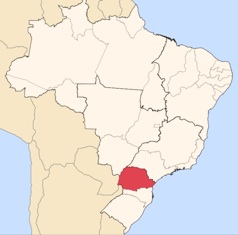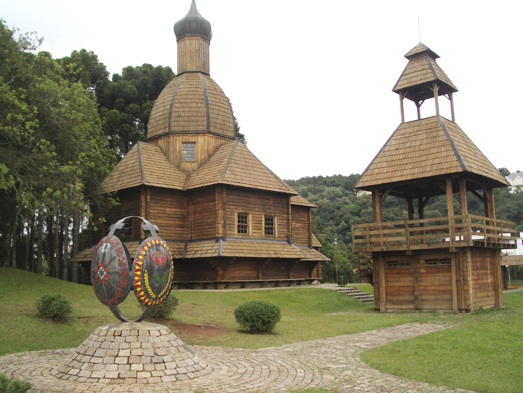Brazil

Immigration
The majority of Ukrainians in Brazil are descended from immigrants who arrived in the country prior to World War I. Large waves of settlers from Austro-Hungarian controlled Galicia (Halychyna) began coming to Brazil in 1895, mostly arriving through the port city of Paranaguá. During a period of time known as the "Brazilian fever", between 1895–1897, more than 20,000 Ukrainian small farmers and landless peasants came to Brazil , having been lured by promises of cheap land with good black soil.
The Brazilian government was interested in increasing European settlement, often paid for travel (thus enabling the poorest members of society to emigrate), and even promised to provide clothing and food to the settlers. Soon after arriving, however, the settlers found that the promises were not kept. They were given plots of uncleared land far away from civilization and weren't given any assistance. The settlers were unfamiliar with the strange climate and how to cultivate it, succumbed to diseases without any medical help, and experienced many deaths. Their suffering became known in Ukraine and even became the subject of a series of poems, "To Brazil", by the well-known Ukrainian poet Ivan Franko. After news of their misfortune spread throughout western Ukraine, the flow of Ukrainian emigrants to Brazil decreased considerably, and Canada replaced Brazil as the main destination for Ukrainians leaving for the New World.

Ukrainian immigrants in Brazil, 1890s
Hromada

The Ukrainian Greek Catholic Church has a strong hold on Ukrainian society in Brazil, where it is wealthy and has massive landholdings including 230 churches and five monasteries run by the Order of Saint Basil the Great. Approximately 85% of Brazil's Ukrainians belong to this Church. Lavish onion-domed churches proliferate throughout the villages in the Ukrainian part of Brazil, despite the modest economic means of the farmers. In Prudentópolis, the regional center in Parana whose population is 75% Ukrainian, the Ukrainian Catholic Cathedral of São Josafat overlooks the city center. There is also a seminary, and Ukrainian printing press run by the Church and a Ukrainian cultural museum.
Although most Brazilian Ukrainians have lived in Brazil for 4-5 generations and few have ever seen Ukraine, they have preserved their language and culture to a large degree in rural Paraná state This has largely been due to the colossal efforts of the Ukrainian Churches. Among those who live in the colonies, or agricultural settlements, Ukrainian is widely spoken at home, in church, and in the community, and today it is not uncommon for Ukrainian children to be unable to speak the Portuguese language until they begin school. Despite the Ukrainian language's widespread use in everyday speech, the ability to read and write is more limited, with over 50% of the Ukrainian population being unable to write in the Ukrainian language. Due to isolation from Ukraine, the Ukrainians of Brazil speak a 100-year-old form of the language's Galician or "Upper Dniestrian" dialect. In the rural areas, Ukrainians rarely marry non-Ukrainians, and mixed marriages generally adopt the Ukrainian culture.

The blessing of the Easter baskets
Pysankarstvo in Brazil
Pysankarstvo is widespread in Ukrainian Brazil, along the same model as in North America. It has become a craft practiced by ethnic Ukrainians, largely taught in classes (rather than passed along from mother to daughter). The designs written are largely modern, with influences form North America being evident (e.g. Trypillian eggs and patterns from the UGS books).
A Brazilian specialty is the writing of pysanky on small eggs (quail). There seems to be widespread use of calligraphy type pens and nibs for the writing of pysanky, although more traditional styluses are used as well.


There are several websites devoted to the “Pêssanka,” and several books have been published on the subject, along with at least one DVD. In 2007 Eduardo Sganzerla published “Pêssanka: the Ukrainian art of egg painting in Brazil” in both English and Portuguese. It contains history, “simbology,” and profiles of several Brazilian pysankary. Unfortunately, he book was not professionally translated, and is almost unreadable; I have trouble understanding what is being said.
Below and the in photo above are examples of Brazilian pysanky written by Vilson José Kotviski.

Back to History home page
Back to MAIN Pysanka home page.
Back to Pysanka Index.
Search my site with Google
The Other Diaspora

Parque Tingui, Curitiba


